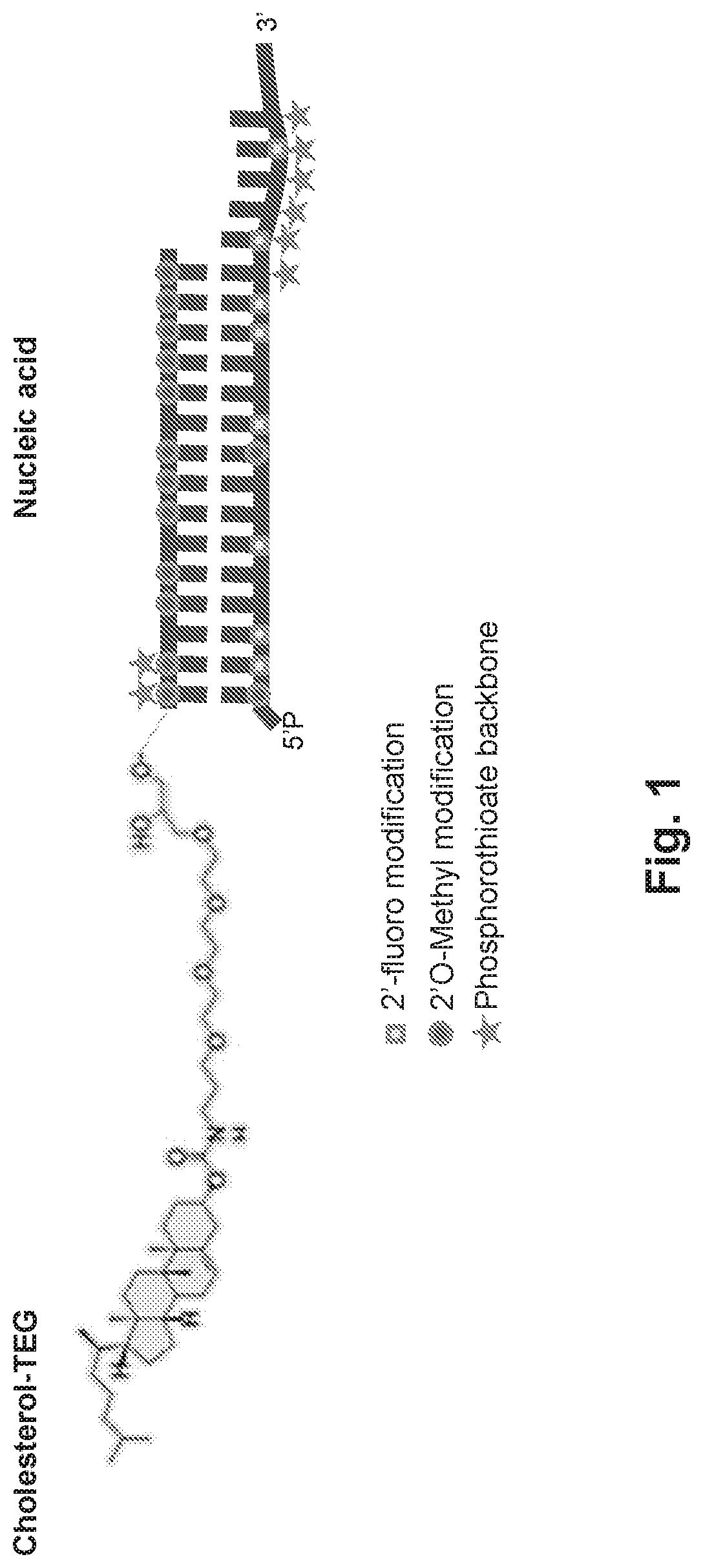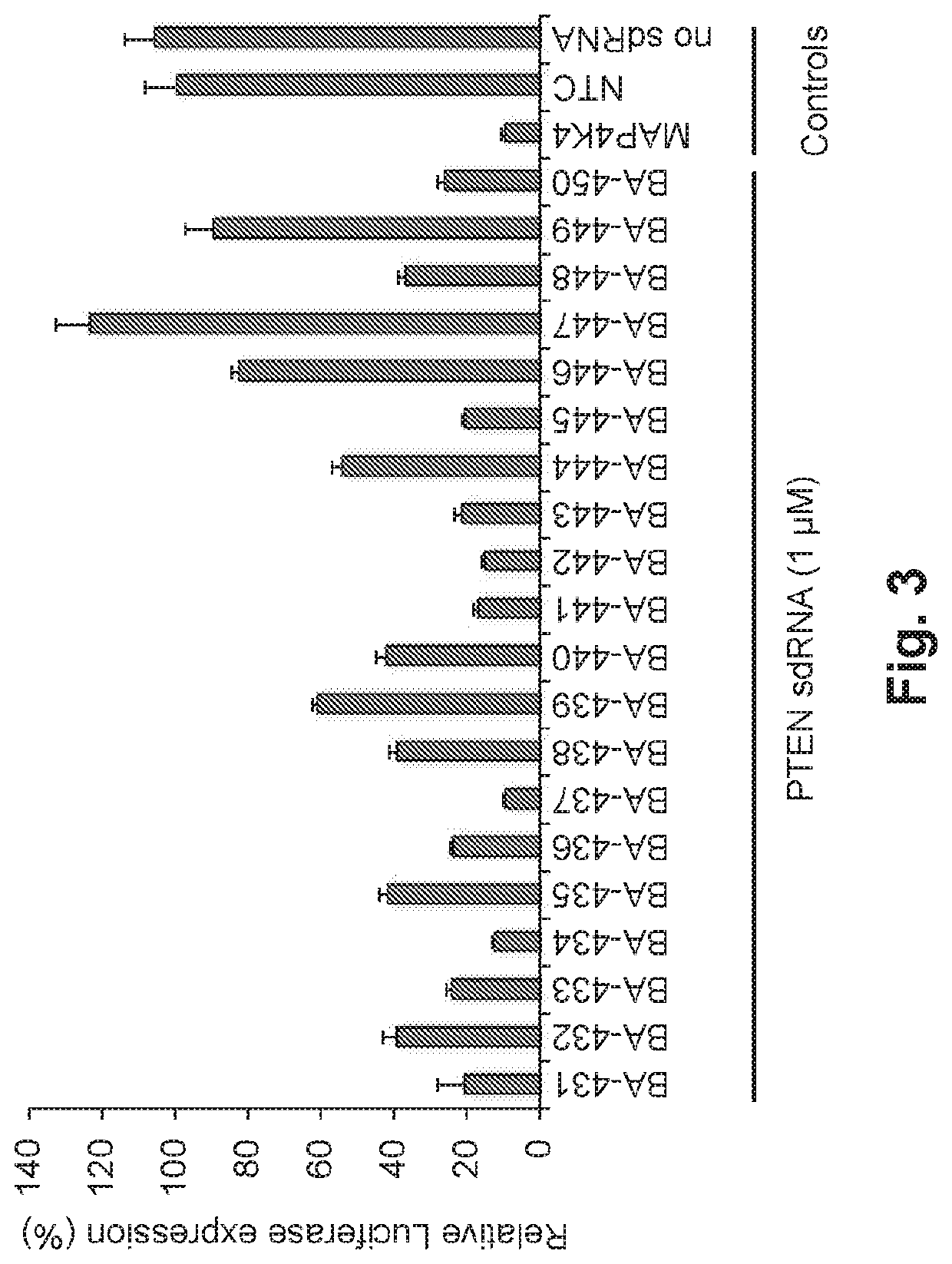Treatment of CNS injury with RNAi therapeutics
a technology of cns injury and rnai, applied in the field of medicine and neurology, can solve the problems of limited clinical studies, few approved drugs to improve functional outcome, and long life of disability, and achieve the effects of enhancing lesion contraction, promoting seclusion of cns infiltrating blood borne monocytes, and enhancing astrocyte migration
- Summary
- Abstract
- Description
- Claims
- Application Information
AI Technical Summary
Benefits of technology
Problems solved by technology
Method used
Image
Examples
example 2
Delivery of sdRNA Into Rat Pheochromaocytoma PC-12 Cells
[0122]PC-12 cells (ATCC) were cultured on collagen I coated vessels in the presence of 100 ng / ml Nerve Growth Factor (NGF) (Sigma-Aldrich, St. Louis, Mo.). For transfection, cells were collected by trypsinization and diluted with RPMI medium containing 1% FBS and 100 ng / ml NGF and seeded into 96-well plate at 10,000 cells / well.
[0123]MAP4K4 sdRNA conjugated with Cy3 fluorophore was added to the cells at 1 μM final concentration. Images were taken on EVOS FL Imaging System (Life Technologies, Carlsbad, Calif.) at various incubation times between 10 min and 24 hrs.
[0124]FIG. 4 demonstrates that Cy3-fluorescence is clearly visible inside the cells, which proves passive, cellular uptake of MAP4K4 sdRNA.
example 3
Validation of sdRNA Gene Silencing Efficacy in PC-12 Cells
[0125]PC-12 cells were cultured as described in EXAMPLE 1. The efficacy of MAP4K4 sdRNA was tested by qRT-PCR. 2× solutions of MAP4K4 and NTC (non-targeting control) sdRNAs were prepared in serum-free EMEM medium, by diluting 100 μM oligonucleotides to 0.08 μM-4 μM final concentration in the total volume of medium for each oligo concentration. Oligonucleotides were dispensed into a 96-well plate at 50 μl / well.
[0126]PC-12 cells were collected for transfection by trypsinization in a 50 ml tube, washed twice with medium containing 10% FBS without antibiotics, spun down at 200× g for 5 min at room temperature and resuspended in EMEM medium containing twice the required amount of FBS for the experiment (2%) and NGF (200 ng / ml). Cell concentration was adjusted to 120,000 cells / ml. Cells were dispensed into 50 μl / well into the 96-well plate with pre-diluted oligos and placed in the incubator for 48 hr.
[0127]Gene expression was analy...
example 4
Validation of PTEN Gene Silencing Efficacy in PC-12 Cells
[0132]Six out of 20 sdRNAs targeting PTEN with more than 70% knock-down efficacy in luciferase assay (FIG. 3), were validated for PTEN gene silencing efficacy in PC-12 cells. The sense and antisense for BA-434 are shown in FIG. 36.
[0133]Solutions of PTEN and NTC (non-targeting control) sdRNAs were prepared in serum-free EMEM medium. The final concentration range of oligonucleotides was 0.04 μM-2 μM. Treatment with sdRNA (48 hr) and qRT-PCR analysis were performed as described in EXAMPLE 3. PTEN expression was normalized to GAPDH and plotted as percent of expression of NTC sdRNA-treated cells.
[0134]FIG. 6 shows that all tested sdRNAs reduced PTEN mRNA expression in a dose-dependent fashion in comparison to NTC. Three sdRNAs, BA-434, BA-441 and BA-442 showed the highest potency in reducing PTEN mRNA levels in PC12 cells (FIG. 6)
PUM
| Property | Measurement | Unit |
|---|---|---|
| volume | aaaaa | aaaaa |
| volume | aaaaa | aaaaa |
| time | aaaaa | aaaaa |
Abstract
Description
Claims
Application Information
 Login to View More
Login to View More - R&D
- Intellectual Property
- Life Sciences
- Materials
- Tech Scout
- Unparalleled Data Quality
- Higher Quality Content
- 60% Fewer Hallucinations
Browse by: Latest US Patents, China's latest patents, Technical Efficacy Thesaurus, Application Domain, Technology Topic, Popular Technical Reports.
© 2025 PatSnap. All rights reserved.Legal|Privacy policy|Modern Slavery Act Transparency Statement|Sitemap|About US| Contact US: help@patsnap.com



